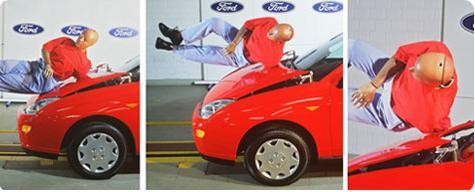Taking the Hit
Hey, how about us Americans?
Pedestrian Safety
Automakers Get Pedestrian-Friendly
Cathy Nikkel / autoMedia.com
Softening the punch of motor vehicles when they hit a pedestrian or cyclist is the next step in automotive safety, but U.S. pedestrians will benefit as an afterthought. This fall regulators in Europe will require that all new vehicles sold in Europe pass crash testing designed to mitigate head and leg injuries in accidents with pedestrians or bicyclists. In 2010, much stricter regulations will go into effect. U.S. pedestrians can expect the initial pedestrian-friendly designs to carry over to this market; but, in the absence of comparable U.S. regulations, the more sophisticated pedestrian-friendly technology geared to meet Europe's 2010 regulations may not be packed under U.S. hoods.
Statistics
Pedestrian deaths in other parts of the world are a bigger problem than in the States. In India, more than 40 percent of traffic fatalities involve pedestrians. Each year 8,000 European pedestrians are killed and 300,000 injured. In the U.S., 5,000 are killed and 70,000 injured
When a pedestrian is hit by a car, their legs are knocked out from under them and the upper body is thrown down—very hard—onto the hood of the car. Today's cars are aerodynamically designed to glean extra miles per gallon. A consequence of this fuel-efficient design is minimal space between the outer body panels and the hard structural components. Serious or fatal head injuries often result because just below the hood, in most cars, is a heavy, rigid engine. In almost all collisions, the pedestrian falls onto the road after the accident has occurred. The exact influence of this on the seriousness of the injury has not been fully investigated, but modifications to the vehicle cannot overcome this aspect of pedestrian accidents.
Pedestrian safety is a major challenge since additional safety systems also increase vehicle weight and raise fuel consumption and exhaust emissions. Protective measures can also influence design and European niche makers like Morgan and Lotus argue that the design adjustments needed to meet the regulations will destroy their distinctive looks and the additional costs will run them out of the market. That remains to be seen.
copy right AutoMedia.com 2010-2012

